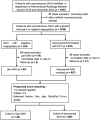Clinical Outcomes of Diffuse Angiogram-Negative Subarachnoid Hemorrhage Versus Aneurysmal Subarachnoid Hemorrhage: A Propensity Score-Matched Analysis
- PMID: 38156544
- PMCID: PMC10863825
- DOI: 10.1161/JAHA.123.031066
Clinical Outcomes of Diffuse Angiogram-Negative Subarachnoid Hemorrhage Versus Aneurysmal Subarachnoid Hemorrhage: A Propensity Score-Matched Analysis
Abstract
Background: The outcome of diffuse angiogram-negative subarachnoid hemorrhage (dan-SAH) compared with aneurysmal SAH (aSAH) remains unclear. This study aimed to compare outcomes using propensity score matching.
Methods and results: Sixty-five patients with dan-SAH and 857 patients with aSAH admitted between January 2018 and December 2022 were retrospectively reviewed. Propensity score matching resulted in matching 65 patients with dan-SAH to 260 patients with aSAH, and clinical outcomes were compared between the groups. Compared with patients with dan-SAH, patients with aSAH were more likely to experience rehemorrhage (8.8% versus 0%, P=0.027), death (11.2% versus 1.5%; odds ratios [OR] 8.04 [95% CI, 1.07-60.12]; P=0.042), or delayed cerebral ischemia (12.3% versus 3.1%; OR, 4.42 [95% CI, 1.03-18.95]; P=0.045). Multivariate analysis revealed that Hunt-Hess grade 4 to 5 (OR, 3.13 [95% CI, 2.11-4.64]; P<0.001), presence of intraventricular hemorrhage (OR, 3.58 [95% CI, 1.72-7.46]; P=0.001), and smoking (OR, 2.44 [95% CI, 1.12-5.28]; P=0.024) were independently associated with the incidence of unfavorable outcomes (modified Rankin scale score >2 at 3 months), whereas dan-SAH was not (OR, 0.66 [95% CI, 0.25-1.73]; P=0.40).
Conclusions: Compared with patients with dan-SAH, patients with aSAH had higher rehemorrhage rates and in-hospital mortality, as well as a higher incidence of delayed cerebral ischemia. Unfavorable outcomes were associated with admission Hunt-Hess grade, the presence of intravenetricular hemorrhage, and smoking history, but there was no relation with the pathogenesis of the hemorrhage (dan-SAH versus aSAH).
Keywords: aneurysmal subarachnoid hemorrhage; clinical outcome; diffuse angiogram‐negative subarachnoid hemorrhage; propensity score matching.
Figures



Similar articles
-
Neutrophil-to-lymphocyte ratio as an independent predictor for unfavorable functional outcome in aneurysmal subarachnoid hemorrhage.J Neurosurg. 2019 Feb 1;132(2):400-407. doi: 10.3171/2018.9.JNS181975. Print 2020 Feb 1. J Neurosurg. 2019. PMID: 30717052
-
Functional Outcomes and Delayed Cerebral Ischemia Following Nonperimesencephalic Angiogram-Negative Subarachnoid Hemorrhage Similar to Aneurysmal Subarachnoid Hemorrhage.Neurosurgery. 2018 Mar 1;82(3):359-364. doi: 10.1093/neuros/nyx188. Neurosurgery. 2018. PMID: 28575305
-
Clinical Outcome and Prognostic Factors of Patients with Perimesencephalic and Nonperimesencephalic Subarachnoid Hemorrhage.World Neurosurg. 2022 Sep;165:e512-e519. doi: 10.1016/j.wneu.2022.06.086. Epub 2022 Jun 24. World Neurosurg. 2022. PMID: 35753679
-
Angiogram-negative subarachnoid hemorrhage: outcomes data and review of the literature.J Stroke Cerebrovasc Dis. 2013 Aug;22(6):750-7. doi: 10.1016/j.jstrokecerebrovasdis.2012.02.001. Epub 2012 Mar 30. J Stroke Cerebrovasc Dis. 2013. PMID: 22465208 Review.
-
Antiplatelet therapy and outcomes after aneurysmal subarachnoid hemorrhage: A systematic review and meta-analysis.Clin Neurol Neurosurg. 2023 Dec;235:108025. doi: 10.1016/j.clineuro.2023.108025. Epub 2023 Oct 26. Clin Neurol Neurosurg. 2023. PMID: 37925994 Free PMC article.
Cited by
-
Spinal dural arteriovenous fistulas presenting as intracranial subarachnoid hemorrhage: A systematic review.Interv Neuroradiol. 2025 Jul 15:15910199251328721. doi: 10.1177/15910199251328721. Online ahead of print. Interv Neuroradiol. 2025. PMID: 40660916 Free PMC article. Review.
-
Perimesencephalic Subarachnoid Hemorrhage Is Not Always a Benign Condition: Hemorrhage Volume as a Predictor for Complications and Clinical Outcome.Biomedicines. 2025 Apr 27;13(5):1061. doi: 10.3390/biomedicines13051061. Biomedicines. 2025. PMID: 40426887 Free PMC article.
-
Case fatality and functional outcome after spontaneous subarachnoid haemorrhage: A systematic review and meta-analysis of time trends and regional variations in population-based studies.Eur Stroke J. 2024 Sep;9(3):555-565. doi: 10.1177/23969873241232823. Epub 2024 Feb 14. Eur Stroke J. 2024. PMID: 38353205 Free PMC article.
-
Prognostic Factors and Imaging Strategies in Unknown Subarachnoid Hemorrhage: A Retrospective Study.Cureus. 2025 May 2;17(5):e83352. doi: 10.7759/cureus.83352. eCollection 2025 May. Cureus. 2025. PMID: 40322610 Free PMC article.
-
Functional outcome, return to work and quality of life in patients with non-aneurysmal subarachnoid hemorrhage.Eur Stroke J. 2025 Aug 13:23969873251362012. doi: 10.1177/23969873251362012. Online ahead of print. Eur Stroke J. 2025. PMID: 40801120 Free PMC article.
References
-
- Connolly ES, Rabinstein AA, Carhuapoma JR, Derdeyn CP, Dion J, Higashida RT, Hoh BL, Kirkness CJ, Naidech AM, Ogilvy CS, et al. Guidelines for the management of aneurysmal subarachnoid hemorrhage: a guideline for healthcare professionals from the American Heart Association/American Stroke Association. Stroke. 2012;43:1711–1737. doi: 10.1161/STR.0b013e3182587839 - DOI - PubMed
-
- Elhadi AM, Zabramski JM, Almefty KK, Mendes GA, Nakaji P, McDougall CG, Albuquerque FC, Preul MC, Spetzler RF. Spontaneous subarachnoid hemorrhage of unknown origin: hospital course and long‐term clinical and angiographic follow‐up. J Neurosurg. 2015;122:663–670. doi: 10.3171/2014.10.JNS14175 - DOI - PubMed
-
- Rinkel GJ, Wijdicks EF, Hasan D, Kienstra GE, Franke CL, Hageman LM, Vermeulen M, van Gijn J. Outcome in patients with subarachnoid haemorrhage and negative angiography according to pattern of haemorrhage on computed tomography. Lancet. 1991;338:964–968. doi: 10.1016/0140-6736(91)91836-J - DOI - PubMed
Publication types
MeSH terms
LinkOut - more resources
Full Text Sources
Miscellaneous

